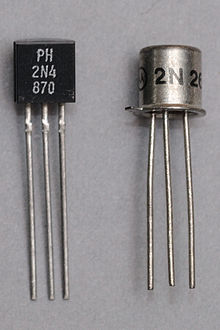- Unijunction transistor
-
A unijunction transistor (UJT) is an electronic semiconductor device that has only one junction. The UJT has three terminals: an emitter (E) and two bases (B1 and B2). The base is formed by lightly doped n-type bar of silicon. Two ohmic contacts B1 and B2 are attached at its ends. The emitter is of p-type and it is heavily doped. The resistance between B1 and B2, when the emitter is open-circuit is called interbase resistance.
There are three types of unijunction transistors:
- The original unijunction transistor, or UJT, is a simple device that is essentially a bar of N type semiconductor material into which P type material has been diffused somewhere along its length, defining the device parameter η. The 2N2646 is the most commonly used version of the UJT.
- The complementary unijunction transistor, or CUJT, that is a bar of P type semiconductor material into which N type material has been diffused somewhere along its length, defining the device parameter η. The 2N6114 is one version of the CUJT.
- The programmable unijunction transistor, or PUT, is a close cousin to the thyristor. Like the thyristor it consists of four P-N layers and has an anode and a cathode connected to the first and the last layer, and a gate connected to one of the inner layers. They are not directly interchangeable with conventional UJTs but perform a similar function. In a proper circuit configuration with two "programming" resistors for setting the parameter η, they behave like a conventional UJT. The 2N6027 is an example of such a device.
The UJT is biased with a positive voltage between the two bases. This causes a potential drop along the length of the device. When the emitter voltage is driven approximately one diode voltage above the voltage at the point where the P diffusion (emitter) is, current will begin to flow from the emitter into the base region. Because the base region is very lightly doped, the additional current (actually charges in the base region) causes conductivity modulation which reduces the resistance of the portion of the base between the emitter junction and the B2 terminal. This reduction in resistance means that the emitter junction is more forward biased, and so even more current is injected. Overall, the effect is a negative resistance at the emitter terminal. This is what makes the UJT useful, especially in simple oscillator circuits.
Unijunction transistor circuits were popular in hobbyist electronics circuits in the 1960s and 1970s because they allowed simple oscillators to be built using just one active device. For example, they were used for relaxation oscillators in variable-rate strobe lights.[1] Later, as integrated circuits became more popular, oscillators such as the 555 timer IC became more commonly used.
In addition to its use as the active device in relaxation oscillators, one of the most important applications of UJTs or PUTs is to trigger thyristors (SCR, TRIAC, etc.). In fact, a DC voltage can be used to control a UJT or PUT circuit such that the "on-period" increases with an increase in the DC control voltage. This application is important for large AC current control.
UJTs can also be used to measure magnetic flux. The hall effect modulates the voltage at the PN junction. This affects the frequency of UJT relaxation oscillators.[2] This only works with UJTs. PUTs do not exhibit this phenomenon.
See also
References
- ^ Ronald M. Benrey (Oct. 1964). "A Repeating Flash You Can Build". Popular Science 185 (4): 132–136. http://books.google.com/books?id=1yUDAAAAMBAJ&pg=PA132.
- ^ Agrawal, S. L.; D. P. Saha, R. Swami, R. P. Singh (23 April 1987). "Digital magnetic fluxmeter using unijunction transistor probe". International Journal of Electronics 63 (6). doi:10.1080/00207218708939196. http://www.tandfonline.com/doi/abs/10.1080/00207218708939196#preview. Retrieved 24 September 2011.
External links
- Diagrams and description of unijunction transistors from American Microsemiconductor
Electronic components Semiconductors Avalanche diode • Barretter • Darlington transistor • DIAC • Diode • Field-effect transistor (FET) • Insulated-gate bipolar transistor (IGBT) • JFET • Light-emitting diode (LED) • Memristor • MOSFET • Photodetector • PIN diode • Silicon-controlled rectifier (SCR) • Thyristor • Transistor • TRIAC • Unijunction transistor (UJT) • Zener diodeVacuum tubes Vacuum tubes (RF) Backward wave oscillator (BWO) • Cavity magnetron • Crossed-field amplifier • Gyrotron • Inductive output tube (IOT) • Klystron • Maser • Traveling-wave tubeAdjustable Passive Connector (Electrical power, Baseband, RF) • Ferrite • Fuse • Resettable fuse • Resistor (Thermistor) • TransformerReactive Categories:- Transistor types
Wikimedia Foundation. 2010.


